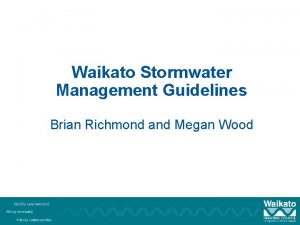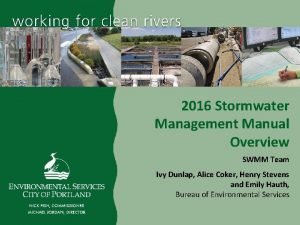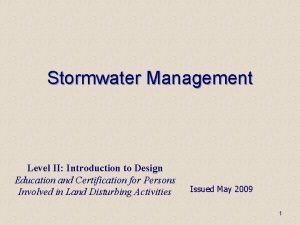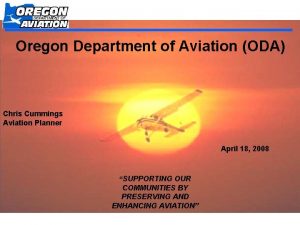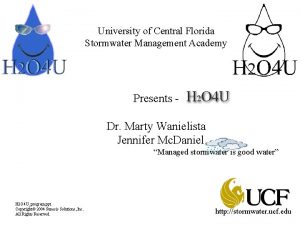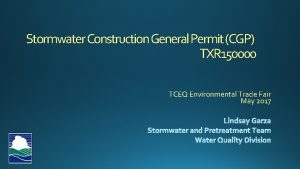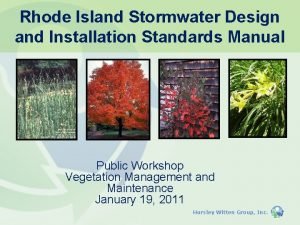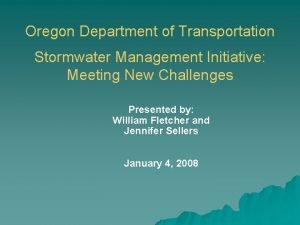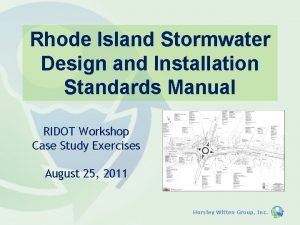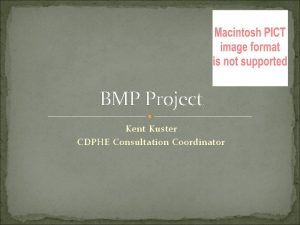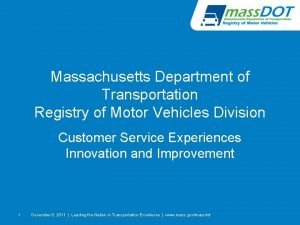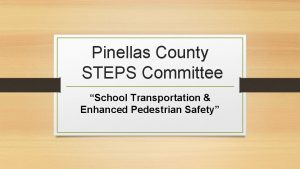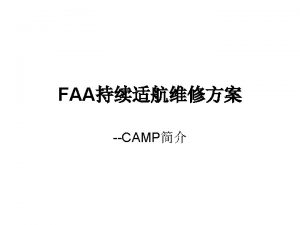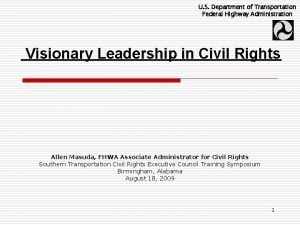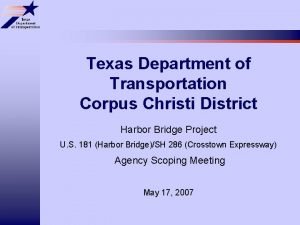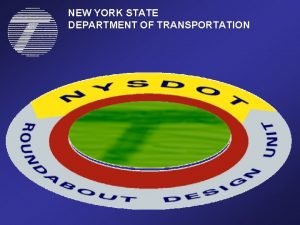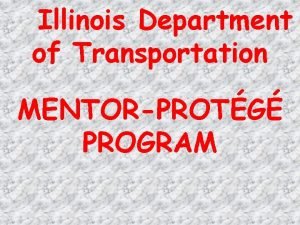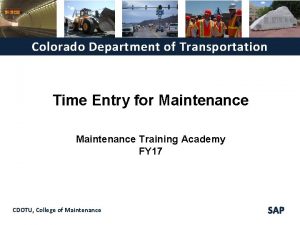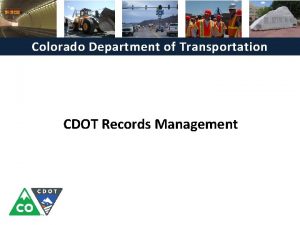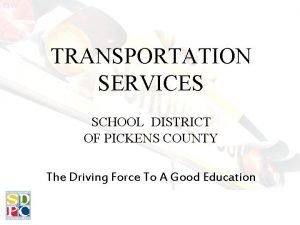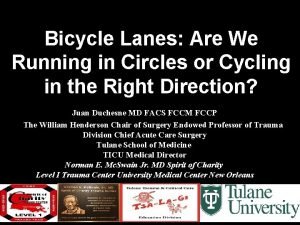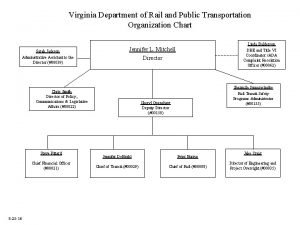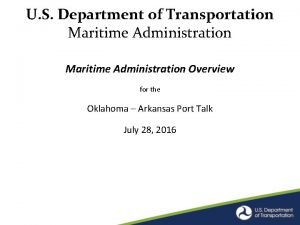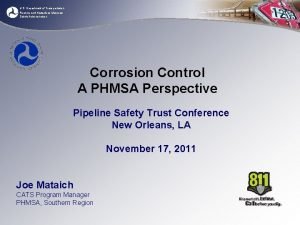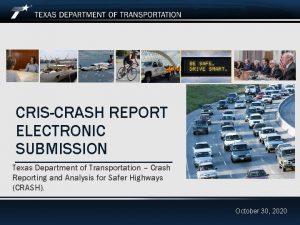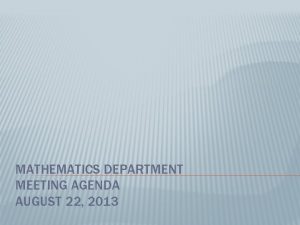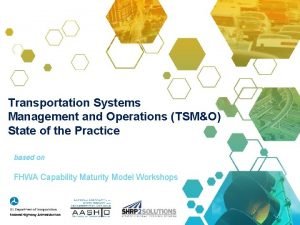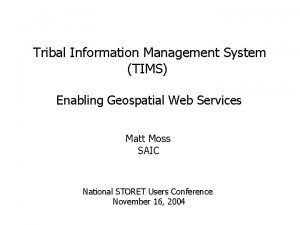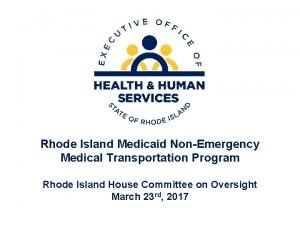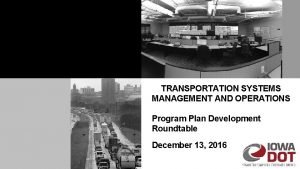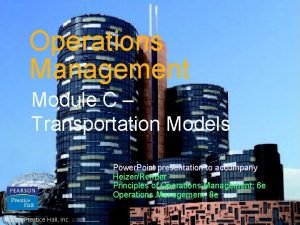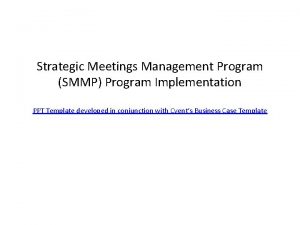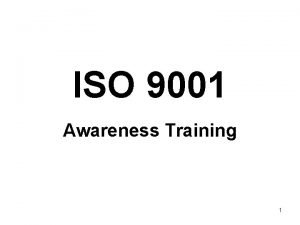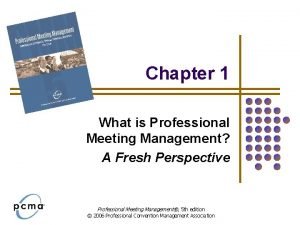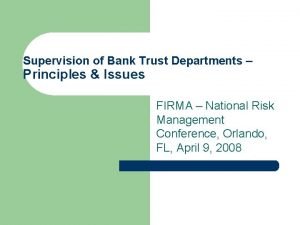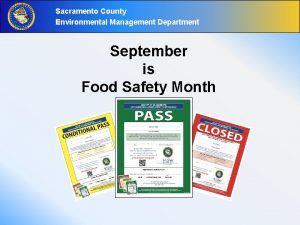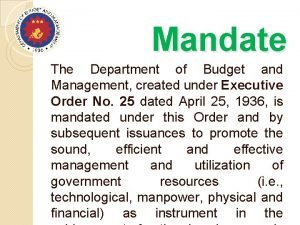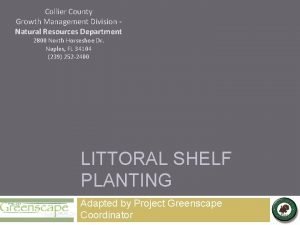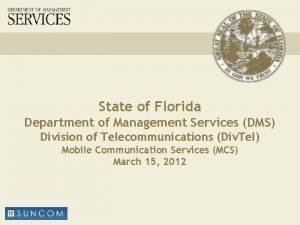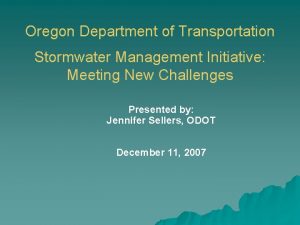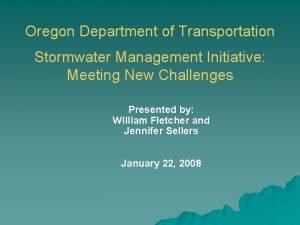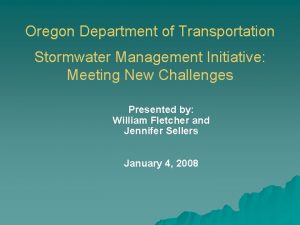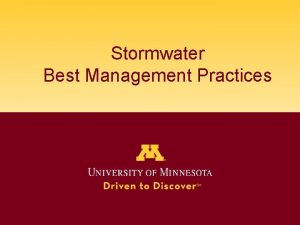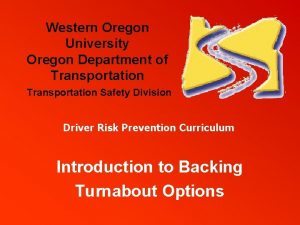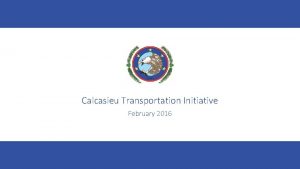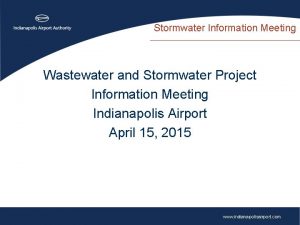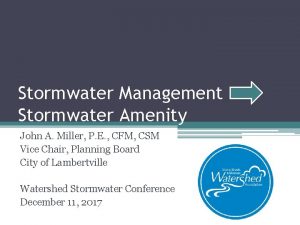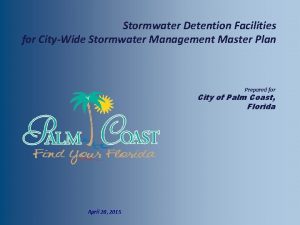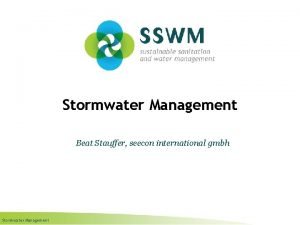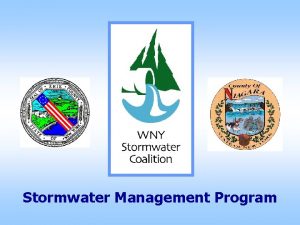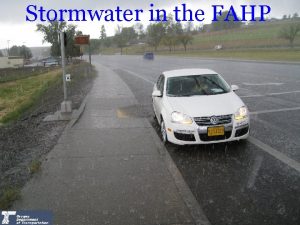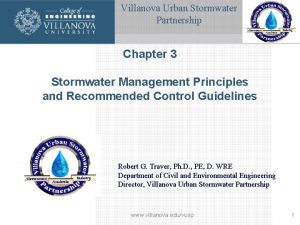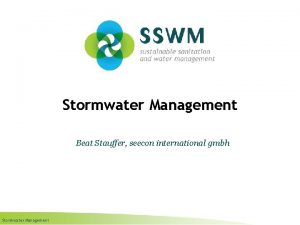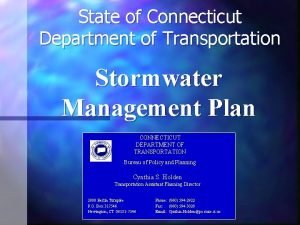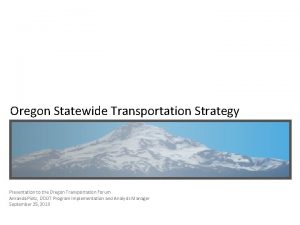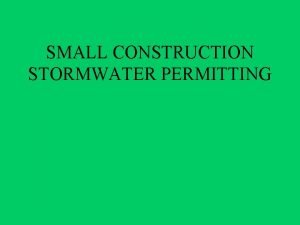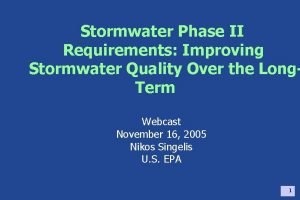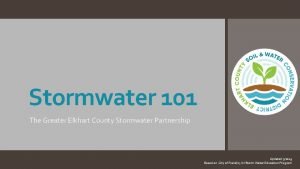Oregon Department of Transportation Stormwater Management Initiative Meeting



















































- Slides: 51

Oregon Department of Transportation Stormwater Management Initiative: Meeting New Challenges Presented by: William Fletcher and Jennifer Sellers January 4, 2008

Overview of Water Quality Issues u Regulation of stormwater is a national issue u Copper has been shown to harm salmonids at very low concentrations u NMFS is basing effect determinations largely on dissolved copper

Problem Statement Stormwater has become a major impediment to efficient ESA consultation process due to: u u Changing criteria for effect determinations in ESA Section 7 consultations Potential extension of the “action area” from the point of discharge to the sea

Problem Statement Changing Criteria u ODOT has based effect determinations on the change between pre-project and post-project conditions u NMFS is basing effect determinations on the absolute quality of the stormwater at the point of discharge

Changing Criteria: Implications to ODOT’s Program Region Biologists were surveyed and estimated a 20 – 50% increase in number of formal consultations

Problem Statement Action Area Current ODOT Action Area Definition u 2 -miles downstream from point of discharge or as project conditions indicate NMFS initially proposed an action area from the point of discharge to the sea

Overall Impact to ODOT’s Program Nightmare Scenario u Required numeric standards u Monitoring to demonstrate compliance u Potential remediation requirements u Consultation gridlock

Solution Strategy Collaborative approach that of the interested parties – ODOT – NMFS – FHWA – DEQ includes all - USFWS ODFW EPA

Solution Strategy Review by and consultation with: u. A Technical Team comprised of hydraulic engineers and stormwater designers from ODOT, DEQ, and FHWA u ODOT Office of Maintenance u ODOT Environmental Leadership Team, Technical Leadership Team, and Area Managers Team

Solution Strategy: ODOT’s Goals Develop a stormwater treatment program to: u Provide ODOT and FHWA with certainty regarding scope, schedule, and budget u Streamline the permitting process u Meet all regulatory needs u Result in an overall environmental benefit and promote species recovery

Solution Strategy: ODOT’s Goals All solutions must be Permitable Constructible Maintainable

Solution Strategy Twin tracks: u Regulatory: Streamline the ESA consultation process u Technical: Develop the process and tools for effective stormwater management

Solution Strategy: Regulatory u Articulation and clarification of Effect Determination criteria and thresholds u Develop tools for Streamlined Permitting

Solution Strategy: Regulatory Effects Determinations u Agree that copper causes sublethal effects to listed salmonids u NMFS develops guidelines for Effects Determinations based on project elements and stormwater management

Solution Strategy: Regulatory Permitting Streamlining Agree on requirements to obtain NMFS buyoff on projects u Develop programmatic approaches to consultation on stormwater issues u Include technical products in SLOPES IV u Use pilot projects using the technical products in consultation to set precedent u

Status: Regulatory u Agreement that if “effective” BMPs are used, then stormwater has been treated to maximum extent feasible u We will not be held to numerical standards for ESA purposes

Status: Regulatory NMFS has provided written guidance for effect determinations LAA: – New “pollutant generating impervious surface” that discharges to surface waters: u. Travel lanes u. Shoulder widening u. Turn lanes

Status: Regulatory NLAA u All stormwater from the Water Quality Design Storm is infiltrated No Effect u Non-Pollutant generating surfaces – Sidewalks – Guardrail flares – Separated bike paths

Status: Regulatory Most Recent NMFS Proposed Action Area Definition (or lack thereof) – Potentially from point of discharge to the ocean or major confluence (default) – Determined on a project-by-project basis – Project team should coordinate with NMFS early on the action area

Status: Regulatory u Pilot projects selected, with active work on one in Region 1 u Proposal for a Stormwater Programmatic rejected u Incorporated preferred BMPs and Design Storms into SLOPES IV

Status: Regulatory u For projects that cannot use SLOPES IV, stormwater analysis and conditions can be inserted into consultations via “incorporation by reference” u FHWA considering becoming a “SLOPES” Action Agency

Solution Strategy: Technical u Clarify and improve ODOT’s process for addressing stormwater management u Develop tools to select the most effective treatment for individual projects u Select design storms based on science

Status: Technical Project Development Process u Baseline Report identified issues u Initial design incorporates stormwater quality management – Low Impact Development techniques – Right-of-way for engineered facilities

Status: Technical Project Development Process (2) u Water Resources Impact Assessment identifies any remaining treatment requirements u BMP Selection Tool used to – Identify and select BMPs – Assemble treatment train – Justify BMP selection u BA incorporates results from BMP Selection process

Status: Technical Design Guidance u BMP Summary Reports Completed u LID Summary Reports in Development u BMP Selection Tool being tested and refined on pilot projects – Draft rating of BMP effectiveness – Preferred BMPs identified u BMP Selection Tool Users’ Guide to be developed

Status: Technical BMP Evaluation High variability with “effectiveness” data u Based on treatment mechanisms – Hydrologic attenuation – Sedimentation/density separation – Sorption – Filtration – Uptake/storage – Microbially-mediated transformation u

Status: Technical BMP Selection

Status: Technical BMP Selection

Status: Technical BMP Selection Priority BMPs for Treating Dissolved Metals u Treatment Mechanisms – Hydrologic Attenuation (infiltration) – preferred – Sorption, uptake, microbial transformation u “Preferred” BMPs – Infiltration trench – Bioretention – Bioslope (“Ecology Embankment”) – Amended Swale and Filter Strip

Status: Technical BMP Selection u Key selection criteria (metrics) – Treatment capability – Physical site suitability – Maintenance – Cost – Resources, risk and public perception

Status: Technical BMP Selection Next Steps u Finalize Metric Ratings u Apply to Pilot Projects u Integrate into an “Electronic Tool” u Develop Users’ Guide

Status: Technical Design Storm Evaluation u Water Quality Design Storms have received regulatory acceptance Flow Control (Water Quantity) Design Storm upper and lower limits accepted u Flow Control threshold of concern proposed u

Status: Technical Design Storms u Water Quality and Water Quantity u Based on climate data u Regionalized u Economics (cost-benefit) Ultimately a “Policy” decision

Status: Technical Water Quality Design Storm Based on analysis of rainfall data from >50 precipitation stations u Cumulative percent of total rainfall vs. storm size u Percentile of storm size u Percent rainfall treated u “Sensitivity Analysis” for sizing treatment facilities

Status: Technical Water Quality Design Storm u Design storm corresponding to 85% cumulative rainfall results in: – >95% of rainfall treated – >97 th percentile storm size u Facility size is most “sensitive” to design storms when increasing from 90% to 95% cumulative rainfall design storm

Status: Technical Water Quality Design Storm

Status: Technical Water Quality Design Storm u Use the mean storm size corresponding to 85% cumulative rainfall for each station in the climate zones. u Define a water quality design storm for 5 zones Zone Current ODOT NMFS Storm (72% 2 year) 85% Cumulative Rainfall 1 1. 6 3. 45 2. 3 2 and 3 1. 0 2. 16 1. 4 4 1. 5 3. 2 2. 3 5 0. 6 1. 3 6, 7, 8, and 9 0. 5 1. 08 0. 7

Status: Technical Flow Control (Water Quantity) Design Storm Lower Discharge Endpoint Eastern OR - 2/3 of 1. 5 -year storm u Western OR - 2/3 of 1. 2 -year storm u Upper Discharge Endpoint Minimally incised streams - Channel bank overtopping event u Incised Streams -10 -year/24 -hour storm event u

Next Steps u u Integration of stormwater management tools into ODOT’s project development process Develop a Watershed Approach to Stormwater Management

Definition of Success u When guidance is approved by regulatory partners u When tools and guidance are in use by project teams u When stormwater is no longer a contentious issue

Questions?


Future Steps: Watershed Approach u Treatment on small projects is often not cost effective u Some projects may not be able to meet water quality goals u Many permitted projects can have residual adverse effects u Highway runoff management may not address priority watershed goals

Watershed Approach u Trading or banking of credits for small projects or projects that cannot meet water quality treatment goals u Mitigation for residual adverse effects from permitted projects u Focus efforts toward maximum benefit to the watershed

I. Streamline the DEQ Stormwater Management Plan Approval Process Problem Statement All applications for SWMPs reviewed in detail by DEQ, which results in u Multiple requests for more information, design changes u Constant danger of schedule slipping u Heavy load on DEQ/ODOT liaison

I. Streamline the DEQ Stormwater Management Plan Approval Process Determine Objectives/ Goal(s) Water Resources Impact Assessment Water Quality Management Design Internal ODOT Quality Control - QC Checklist Optimize Treatment Option Selection ODOT Submits to DEQ - Submittal Application Form - Project Description - Objectives and Goals - Stormwater Treatment Measures - Project Plan Sheets DEQ Reviews SWMP Submittal Package DEQ Approves SWMP

Anticipated Benefits for ODOT and FHWA u Certainty in project development and construction u Reduction in project delays u Contributes to FHWA’s ESA Section 7(a)(1) requirements u Support of ODOT’s sustainability goals

Anticipated Benefits for Regulatory Agencies u Regulatory u ESA-listed protected requirements are met fish and habitat are u Oregon’s water quality and wetland resources are protected u Well-defined permit conditions that allow for flexibility in application u Reduces staff workload

Where We are Now: DEQ u Interagency Agreement with DEQ and ODOT signed u DEQ and ODOT developing training for Region and DEQ staff

Status: Technical Water Quality Design Storm

Status: Technical Water Quality Design Storm
 Waikato stormwater management guideline
Waikato stormwater management guideline Portland stormwater management manual
Portland stormwater management manual Stormwater management
Stormwater management Oda
Oda Oregon water resources department
Oregon water resources department H2o4u
H2o4u Tpdes construction general permit
Tpdes construction general permit Ri stormwater manual
Ri stormwater manual Stormwater
Stormwater Rhode island stormwater manual
Rhode island stormwater manual Cdphe stormwater
Cdphe stormwater Massachusetts department of transportation
Massachusetts department of transportation Montana department of transportation
Montana department of transportation Pinellas county school bus transportation
Pinellas county school bus transportation Department of transportation
Department of transportation Department of transportation
Department of transportation Maricopa county department of transportation
Maricopa county department of transportation Texas department of transportation corpus christi
Texas department of transportation corpus christi Latham traffic circle
Latham traffic circle Department of transportation
Department of transportation 417 extension
417 extension Department of transportation
Department of transportation Department of transportation
Department of transportation Pickens county school transportation department
Pickens county school transportation department Department of transportation
Department of transportation Virginia department of rail and public transportation
Virginia department of rail and public transportation Us department of transportation maritime administration
Us department of transportation maritime administration Department of transportation
Department of transportation Https cris dot state tx us public purchase
Https cris dot state tx us public purchase Today meeting or today's meeting
Today meeting or today's meeting Today meeting or today's meeting
Today meeting or today's meeting What is meeting and types of meeting
What is meeting and types of meeting Types of meeting
Types of meeting Math department meeting agenda
Math department meeting agenda Meeting minutes
Meeting minutes Transportation systems management and operations
Transportation systems management and operations Transportation information management system tims
Transportation information management system tims Does logisticare pay weekly or biweekly
Does logisticare pay weekly or biweekly Transportation systems management and operations
Transportation systems management and operations Transportation model operations management
Transportation model operations management Medicaid transportation texas logisticare
Medicaid transportation texas logisticare Strategic meeting management program
Strategic meeting management program Awareness iso 9001
Awareness iso 9001 Professional meeting management
Professional meeting management Bank trust departments
Bank trust departments Sacramento county environmental management
Sacramento county environmental management Department of budget and management
Department of budget and management Growth management department
Growth management department Dms state of florida
Dms state of florida Top management and middle management
Top management and middle management Management pyramid
Management pyramid Middle level management
Middle level management
